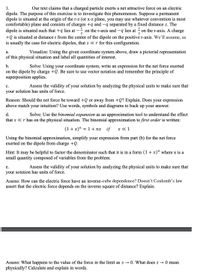Question
Please format answers with correct operator syntax, or use neat handwriting.

Transcribed Image Text:Our text claims that a charged particle exerts a net attractive force on an electric
dipole. The purpose of this exercise is to investigate this phenomenon. Suppose a permanent
dipole is situated at the origin of the r-z (or x-z plane, you may use whatever convention is most
comfortable) plane and consists of charges +q and -q separated by a fixed distance s. The
on the r-axis and -q lies at on the r-axis. A charge
1.
dipole is situated such that +q lies at
--
2
2
+Q is situated at distance r from the center of the dipole on the positive r-axis. We’ll assume, as
is usually the case for electric dipoles, that s «r for this configuration.
а.
Visualize: Using the given coordinate system above, draw a pictorial representation
of this physical situation and label all quantities of interest.
b.
Solve: Using your coordinate system, write an expression for the net force exerted
on the dipole by charge +Q. Be sure to use vector notation and remember the principle of
superposition applies.
с.
Assess the validity of your solution by analyzing the physical units to make sure that
your solution has units of force.
Reason: Should the net force be toward +Q or away from +Q? Explain. Does your expression
above match your intuition? Use words, symbols and diagrams to back up your answer.
Solve: Use the binomial expansion as an approximation tool to understand the effect
that s «r has on the physical situation. The binomial approximation to first order is written:
d.
(1+x)" = 1 + nx if
x « 1
Using the binomial approximation, simplify your expression from part (b) for the net force
exerted on the dipole from charge +Q.
Hint: It may be helpful to factor the denominator such that it is in a form (1 + x)" where x is a
small quantity composed of variables from the problem.
е.
Assess the validity of your solution by analyzing the physical units to make sure that
your solution has units of force.
Assess: How can the electric force have an inverse-cube dependence? Doesn’t Coulomb’s law
assert that the electric force depends on the inverse square of distance? Explain.
Assess: What happens to the value of the force in the limit as s → 0. What does s → 0 mean
physically? Calculate and explain in words.
Expert Solution
This question has been solved!
Explore an expertly crafted, step-by-step solution for a thorough understanding of key concepts.
Step by stepSolved in 3 steps with 1 images

Knowledge Booster
Similar questions
arrow_back_ios
arrow_forward_ios